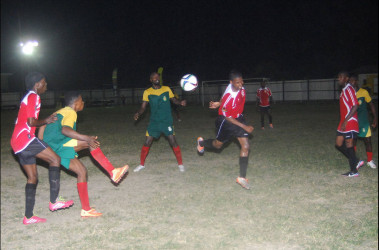Despite only three rounds of the championships being concluded to date, the Guyana Football Federation’s (GFF) Stag Beer Elite League has provided a competitive vehicle following the absence of structured national league.
The inaugural championships have provided for entertaining and enthralling viewing with large crowds swarming the respective venues to witness the action.
In terms of the quality on display, the teams, with their contrasting tactics, have not disappointed with only four points separating second place from seventh.
According to one spectator “The matches have been good so far and it seems like the smaller teams have come with a distinct plan on how to deal with the bigger teams. It does not seem like it will be a walk in the park for the likes of Alpha United and Slingerz FC.”
 Another viewer shared similar sentiments, stating: “The bigger and more established teams will have to work for their wins. The smaller clubs are out to prove a point that they can compete.”
Another viewer shared similar sentiments, stating: “The bigger and more established teams will have to work for their wins. The smaller clubs are out to prove a point that they can compete.”
Similarly, the event’s management staff must also be commended for their current efforts, delivering a quality and properly organized programme every match day.
The sitting areas which have always been a problem for most venues have been countered with traditional portable chairs while the customary issue of spectators encroaching on the playing area and touch line has been negated by the utilization of roped barriers.
Parking for vehicles has also been dealt with by the management staff with security personnel stationed in the aforementioned areas to curtail any possibility of deviancy while portable washroom areas have been provided at venues which lack such facilities, alleviating a constant problem whenever nature calls.
While the tourney has been smoothly run both on and off the field for most parts, the event does have its draw back with the only issue coming from the officiating side.

Inconsistency has been the watchword for the officials, with several matches being officiated in a manner that leaves a lot of room of improvement.
According to another enthusiast, “The referees and linesmen have been missing several calls which have hampered the game. In some games, the calls seem strange and I hope they get better as the competition goes on.”
With the selling point of the event being the nation’s best teams and players competing, the same tagline must be applied to the officials.
This is not an indictment on the officials even though as one of the most important aspects of the event they have faltered in the earlier stages but have not failed and have enough time to remedy those issues.
Another negative that is associated with the event is the fact that players have to pay a fine for every yellow and red card incurred. Some pundits argue that this stipulation will curtail dangerous throughout play in the event.
However, this rule places players under further pressure as they clubs will be penalised financially for aspect of the game that does not warrant it. Yellow and red cards are they for a reason and are effective when instituted correctly.
Attaching a fine to picking up a card feels more like a money making instrument. A player or club should be fined for the severity of the offence and not simply for the colour of the card.
It also raises the question since players are forced to pay a fine for every yellow or red card offence, will the same measure and approach be applied to the officials for poor officiating as important matches could be decided inadvertently by the mistakes of the officials.
One would tend to agree with fines that have been imposed on teams for late arrival at venues and for failing to properly clean their surroundings following the conclusion for matches. However, unless a reckless and dangerous challenge warrants a financial penalty, then a card should simply be a card.
Overall the tournament has brought a breath of fresh air to the football fraternity, providing the avenue for many players, coaches and the often forgotten referees to showcase their abilities on a grand stage. Let’s hope this continues for the foreseeable lifespan of the event.









